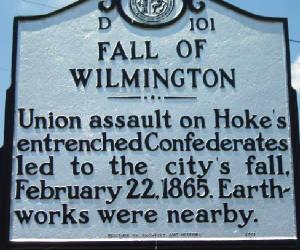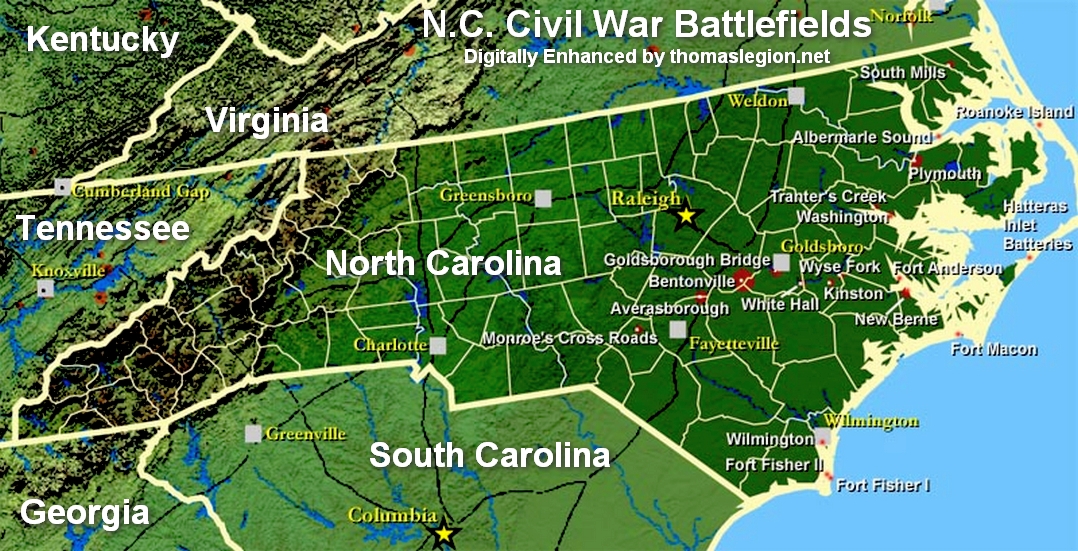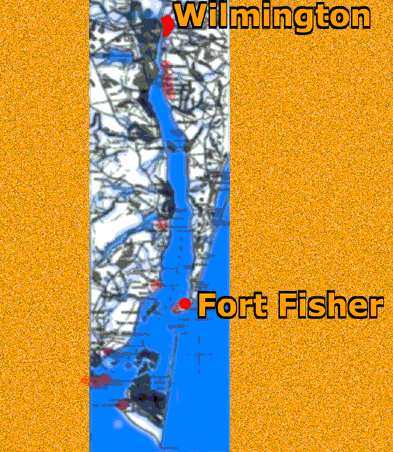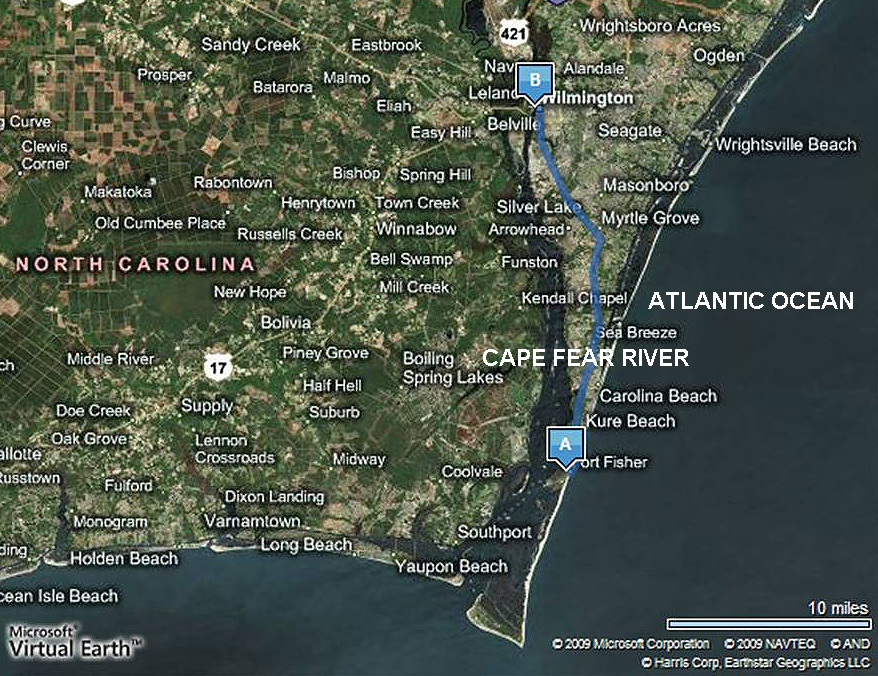|
Battle of Wilmington
Wilmington Civil War History
Other Names: Fort Anderson, Town Creek, Forks Road, Sugar Loaf Hill
Location: New Hanover County
Campaign: Operations against Fort Fisher and Wilmington (January-February
1865)
Date(s): February 12-22, 1865
Principal Commanders: Maj. Gen. John Schofield [US]; Gen. Braxton
Bragg [CS]
Forces Engaged:Cox’s, Ames’s, and Paine’s Divisions
(12,000) [US]; Hoke’s Division, Hagood’s Brigade (6,600) [CS]
Estimated Casualties: 1,150 total
Introduction: The
Battle of Wilmington was fought February 12–22, 1865, during the American Civil War (1861-1865), mostly outside the
city of Wilmington, North Carolina. The Union victory in January in the Second Battle of Fort Fisher meant that Wilmington,
30 miles upriver, could no longer be used by the Confederacy as a port. It fell to Union troops after they overcame Confederate
defenses along the Cape Fear River south of the city. The Confederate General Braxton Bragg burned stores of tobacco and cotton,
among other supplies and equipment, before leaving the city, to prevent the Union from seizing them.
| The Fall of Wilmington: Historical Marker |

|
| (The Battle of Wilmington) |
Background: After the fall of Fort Fisher, the port city of Wilmington was sealed to any further
blockade runners; the Confederates had no remaining major ports along the Atlantic seaboard. Confederate forces evacuated
the other defensive works near the mouth of the Cape Fear River; they were forced to disable and abandon the heavy artillery
since they lacked the means to move them upriver. While the Confederate defeat at Fort Fisher the previous month affected
morale somewhat and led to an increase in desertion, the remaining soldiers also reported that morale remained high. General
Braxton Bragg commanded the defenses of Wilmington; his field forces consisted of General Robert F. Hoke's division from the
Army of Northern Virginia and some heavy artillery men and home guard. Hoke commanded three of his brigades on the east side
of the Cape Fear River, along Sugar Loaf north of Fort Fisher; Hoke's fourth brigade occupied Fort Anderson on the west side
of the river. Bragg remained in Wilmington in order to remove a stockpile of government stores and also to prevent the Union
forces on the coast from reinforcing Major General William T. Sherman's army.
Union general in chief, U.S. Grant, wanted to use Wilmington as a base for
an advance to Goldsboro, North Carolina; rail lines from the coast to Goldsboro could be used to resupply William T. Sherman's
armies, which were then moving north through the Carolinas. In February 1865, the Union XXIII Corps arrived to reinforce the
Fort Fisher Expeditionary Corps, commanded by Major General Alfred H. Terry. Maj. Gen. John M. Schofield took command of the
combined force and started moving against the city in mid-February.
| Map of North Carolina Civil War Battlefields |

|
| Battle of Wilmington, North Carolina |
| Wilmington, North Carolina, Civil War History |

|
| Cape Fear Defense System with Fort Fisher and Wilmington |
| Wilmington, North Carolina, Civil War Battle |

|
| North Carolina Civil War Map of Battlefields |
Battle: With the fall of Fort Fisher to Maj. Gen. Alfred Terry’s and Rear Adm. David Porter’s
combined operation on January 15, 1865, Wilmington’s days were numbered. About 6,600 Confederate troops under Maj. Gen.
Robert Hoke held Fort Anderson and a line of works that prevented the Federals from advancing up the Cape Fear River. Early
February, the XXIII Corps arrived at Fort Fisher, and Maj. Gen. John Schofield took command of the Union forces. Schofield
now began a series of maneuvers to force the Confederates to abandon their defenses. On February 16, Jacob Cox’s division
ferried across the river to confront Fort Anderson, while Porter’s gunboats bombarded the fort. On February 17-18, Ames’s
division conducted a wide flanking march to get in the fort’s rear. Seeing the trap ready to close, the Confederates
evacuated Fort Anderson during the night of the 18th-19th, withdrawing to Town Creek to form a new defensive line. The next
day, this line collapsed to increasing Federal pressures. During the night of February 21-22, Gen. Braxton Bragg ordered the
evacuation of Wilmington, burning cotton, tobacco, and government stores.
Aftermath: The Battle of Wilmington closed the last major port of the Confederate States on the
Atlantic coast. Wilmington had served as a major port for blockade-runners, carrying tobacco, cotton, and other goods to places
such as Great Britain, the Bahamas, and Bermuda; much of the supplies for the Army of Northern Virginia came through Wilmington.
Now with the port closed, the Union blockade was complete; the Confederates were unable to find another port along the Atlantic
seaboard to replace Wilmington. Bragg came under severe criticism from the press for the Confederate defeat in the Wilmington
Campaign. Several members of the Confederate Congress also directed criticism towards Confederate President Jefferson Davis
and called for his resignation. Bragg's forces from Wilmington retreated towards Goldsboro, North Carolina, where it united
with other Confederate forces commanded by General Joseph E. Johnston.
The capture of Wilmington gave
Sherman's forces a base of supply and a supply route to the sea. Schofield was forced to spend some time repairing the damage
caused by the Confederates to the rail lines near the city; he was also forced to use supplies earmarked for Sherman to help
paroled prisoners sent to Wilmington and the civilians still living in the city. Schofield's forces were reorganized into
the Army of the Ohio and from Wilmington he marched inland to join with Sherman's forces near Fayetteville.
| Fort Fisher (A) to Wilmington (B) Route Map |

|
| Two Strategic North Carolina Civil War Battles |
Analysis: With the fall of Fort Fisher as a result of the Second Battle of Fort Fisher on January 15, 1865, the “seal of doom was put on the Confederacy.” Gen. Braxton Bragg, commanding
the defense of the lower Cape Fear, soon
after relinquished other positions, beginning with Fort Caswell
and Fort Campbell
on January 16. Gen. Robert F. Hoke was entrenched about three miles south of Wilmington
with his left flank on Masonboro Sound and his right on the river. His line defending Wilmington
was seen as impregnable and no effort was made to break it until the latter part of February. The earthworks were considerably
strengthened during that month’s time. (Cape Fear River Map and Approaches to Fort Fisher, Fort Anderson, and
Wilmington.)
The march of Federal troops
toward the port city began in earnest on February 20. Initially meeting little resistance, the troops under overall command
of Gen. Jacob D. Cox found Hoke’s men in their trenches at Forks Road.
Among the Union forces were the 5th U.S. Colored Troops, six of whom were wounded by a shell
explosion. The Union field commander, A. H. Terry, ordered a frontal assault and one man was killed and forty-eight wounded.
The Confederates held the works through the night of February 20. The next day, with the support of a flotilla of gunboats
offshore, the Federals claimed victory. The Confederates abandoned the breastworks on the evening of February 21 and the next
morning Union troops moved into Wilmington. With the Wilmington and Weldon railroad captured, it removed Gen. Lee's sole
avenue of support to his beleaguered Army of Northern Virginia. Six weeks after Wilmington fell, Lee would surrender to Grant
at Appomattox, Virginia.
Today
the breastworks south of Wilmington have been largely lost
to development. One well-defined section remains one-fourth mile south of the intersection of Shipyard Boulevard and Seventeenth Street.
The conflict of February 20-21 is known locally as the “Battle of Jumping Run,” but there is no contemporary evidence
that such a term was in use at the time of the fighting.
(Sources and related
reading listed below.)
Recommended
Reading: The Wilmington Campaign and the Battle for Fort Fisher, by Mark A. Moore. Description:
Full campaign and battle history of the largest combined operation in U.S.
military history prior to World War II. By late 1864, Wilmington
was the last major Confederate blockade-running seaport open to the outside world. The final battle for the port city's protector--Fort Fisher--culminated
in the largest naval bombardment of the American Civil War, and one of the worst hand-to-hand engagements in four years of
bloody fighting. Continued below…
Copious illustrations,
including 54 original maps drawn by the author. Fresh new analysis on the fall of Fort Fisher, with a fascinating comparison
to Russian defenses at Sebastopol during the Crimean War. “A tour de force. Moore's Fort Fisher-Wilmington Campaign is the best publication of this
character that I have seen in more than 50 years.” -- Edwin C. Bearss, Chief Historian Emeritus, National Park Service
Related Studies:
Recommended
Reading: Gray Phantoms of the Cape Fear : Running the Civil War Blockade. Description: After the elimination of Charleston in 1863 as a viable entry port for running the blockade, Wilmington, North
Carolina, became the major source of external supply for the Confederacy during
the Civil War. The story of blockade running on the Cape Fear River
was one of the most important factors determining the fate of the South. With detailed and thought-provoking research, author
Dawson Carr takes a comprehensive look at the men, their ships, their cargoes, and their voyages. Continued below…
In mid-1863,
the small city of Wilmington, North Carolina, literally found itself facing a difficult task: it
had to supply Robert E. Lee's army if the South was to continue the Civil War. Guns, ammunition, clothing, and food had to
be brought into the Confederacy from Europe, and Wilmington
was the last open port. Knowing this, the Union amassed a formidable blockading force off storied Cape Fear. What followed was a contest unique in the annals of
warfare. The blockade runners went unarmed, lest their crews be tried as pirates if captured. Neither did the Union fleet
wish to sink the runners, as rich prizes were the reward for captured cargoes. The battle was thus one of wits and stealth
more than blood and glory. As the Union naval presence grew stronger, the new breed of blockade runners got faster, quieter,
lower to the water, and altogether more ghostly and their crews more daring and resourceful. Today, the remains of nearly
three dozen runners lie beneath the waters of Cape Fear,
their exact whereabouts known to only a few fishermen and boaters. Built for a special mission at a brief moment in time,
they faded into history after the war. There had never been ships like the blockade runners, and their kind will never be
seen again. Gray Phantoms of the Cape
Fear tells the story
of their captains, their crews, their cargoes, their opponents, and their many unbelievable escapes. Rare photos and maps.
“This book is nothing shy of a must read.”
Recommended Reading: The Wilmington Campaign: Last
Departing Rays of Hope. Description: While prior books on the battle to capture Wilmington, North Carolina, have
focused solely on the epic struggles for Fort Fisher, in many respects this was just the beginning of the campaign. In addition
to complete coverage (with significant new information) of both battles for Fort Fisher, "The Wilmington Campaign" includes
the first detailed examination of the attack and defense of Fort Anderson. Continued below…
It also features
blow-by-blow accounts of the defense of the Sugar Loaf Line and of the operations of Federal warships on the Cape Fear River. This masterpiece
of military history proves yet again that there is still much to be learned about the American Civil War. "The Wilmington Campaign is a splendid achievement. This gripping chronicle of the five-weeks'
campaign up the Cape Fear River adds a crucial dimension to our understanding of the Confederacy's
collapse." -James McPherson, Pulitzer Prize-winning author of Battle Cry of Freedom
Recommended
Reading: Fort Anderson: The Battle For Wilmington. Description: A detailed but highly readable study of the largest
and strongest interior fortification guarding the Confederacy's last major seaport of Wilmington,
North Carolina. An imposing earthen bastion, Fort Anderson was the scene of a massive two-day
Union naval bombardment and ground assault in late February 1865. Continued below…
The fort's
fall sealed Wilmington's doom. More than a military campaign study, Fort
Anderson: Battle for Wilmington
examines the history of the fort's location from its halcyon days as North Carolina's leading
colonial port of Brunswick
to its beginnings as a Confederate fortification in 1862 and its fall to Union forces three years later. The fort also had
several eerie connections to President Abraham Lincoln's assassination. Today the fort is part of the tranquil Brunswick Town
State Historic Site. Fort Anderson: Battle for Wilmington is liberally illustrated
with maps and illustrations, including many previously unpublished soldiers' images. It also contains an order of battle,
endnotes, bibliography and index.
Recommended
Reading: Confederate Goliath: The Battle of
Fort Fisher. From Publishers Weekly: Late in the Civil War, Wilmington,
N.C., was the sole remaining seaport supplying Lee's army at Petersburg, Va., with rations and munitions. In this dramatic
account, Gragg describes the two-phase campaign by which Union forces captured the fort that guarded Wilmington and the subsequent
occupation of the city itself--a victory that virtually doomed the Confederacy. In the initial phase in December 1864, General
Ben Butler and Admiral David Porter directed an unsuccessful amphibious assault against Fort Fisher that included the war's heaviest
artillery bombardment. Continued below…
The second
try in January '65 brought General Alfred Terry's 9000-man army against 1500 ill-equipped defenders, climaxing in a bloody
hand-to-hand struggle inside the bastion and an overwhelming Union victory. Although historians tend to downplay the event,
it was nevertheless as strategically decisive as the earlier fall of either Vicksburg or Atlanta. Gragg
has done a fine job in restoring this important campaign to public attention. Includes numerous photos.
Recommended Reading: The Civil War in the Carolinas (Hardcover). Description: Dan Morrill relates the experience of two quite different states bound together in
the defense of the Confederacy, using letters, diaries, memoirs, and reports. He shows
how the innovative operations of the Union army and navy along the coast and in the bays and rivers of the Carolinas
affected the general course of the war as well as the daily lives of all Carolinians. He demonstrates the "total war" for
North Carolina's vital coastal railroads and ports. In
the latter part of the war, he describes how Sherman's operation
cut out the heart of the last stronghold of the South. Continued below...
The author
offers fascinating sketches of major and minor personalities, including the new president and state governors, Generals Lee,
Beauregard, Pickett, Sherman, D.H. Hill, and Joseph E. Johnston. Rebels and abolitionists, pacifists and unionists, slaves
and freed men and women, all influential, all placed in their context with clear-eyed precision. If he were wielding a needle
instead of a pen, his tapestry would offer us a complete picture of a people at war. Midwest Book Review: The Civil War in the Carolinas by civil war expert and historian
Dan Morrill (History Department, University of North Carolina at Charlotte, and Director of the Charlotte-Mecklenburg Historical
Society) is a dramatically presented and extensively researched survey and analysis of the impact the American Civil War had
upon the states of North Carolina and South Carolina, and the people who called these states their home. A meticulous, scholarly,
and thoroughly engaging examination of the details of history and the sweeping change that the war wrought for everyone, The
Civil War In The Carolinas is a welcome and informative addition to American Civil War Studies reference collections.
Sources: Chris
Fonveille, The Wilmington Campaign: Last Rays of Departing Hope (1997); Abraham J. Palmer, History of the Forty-Eighth Regiment
New York State Volunteers in the War for the Union, 1861-1865 (1885); John G. Barrett, The Civil War in North Carolina (1963);
The War of the Rebellion: Official Records of the Union and Confederate Armies, ser. 1, XLVII, pt. 2, pp. 509-510, 1234-1235.
|

